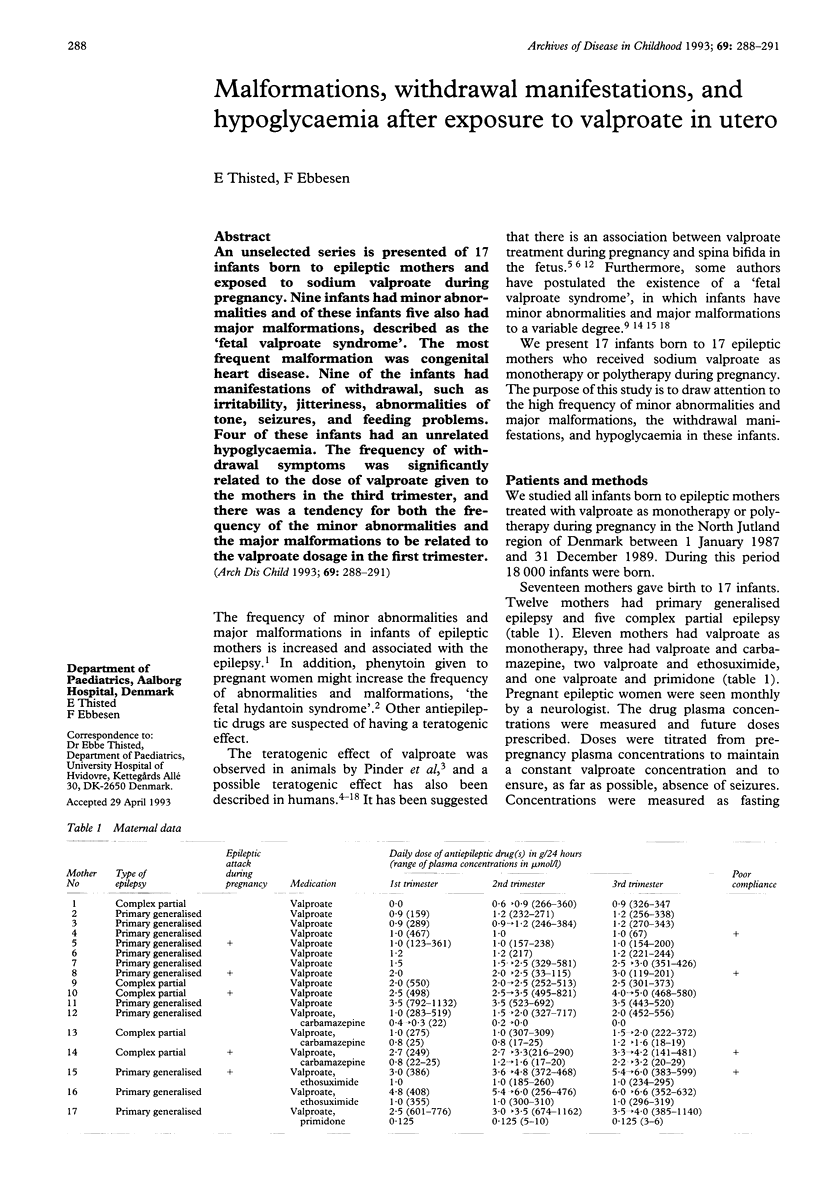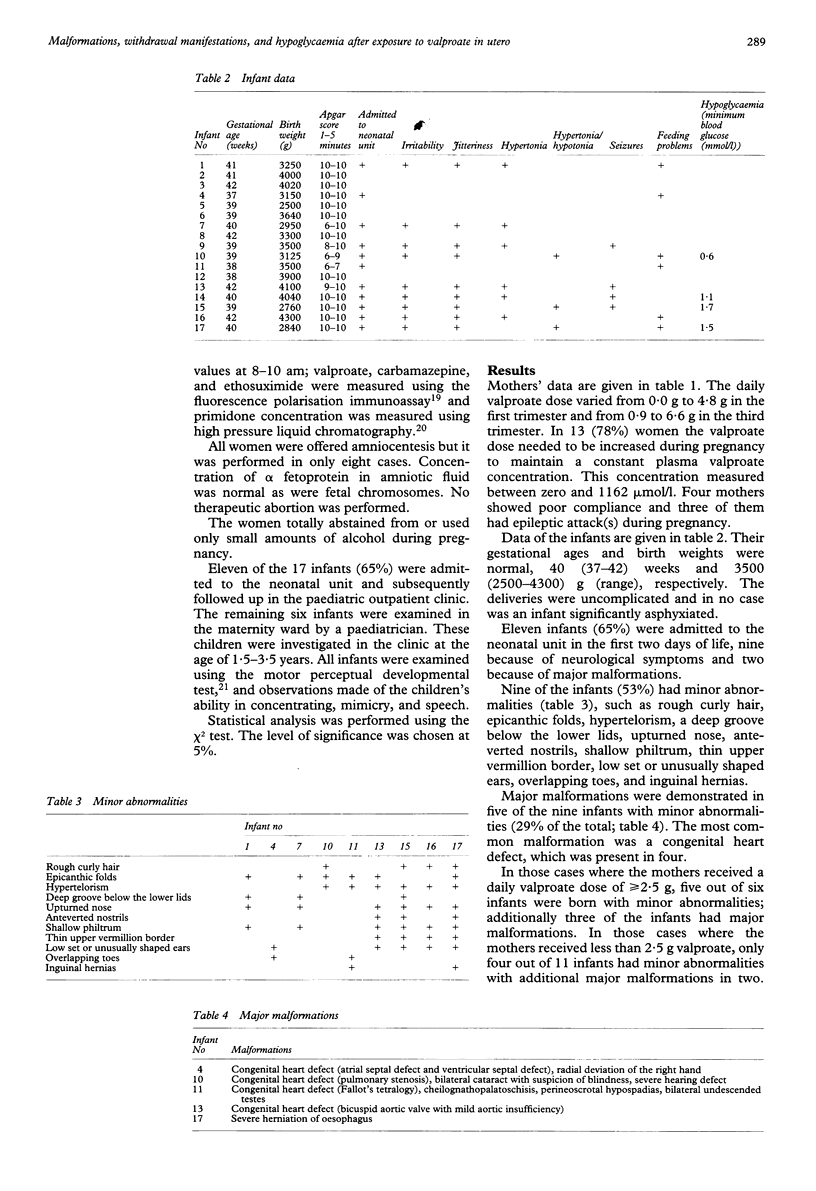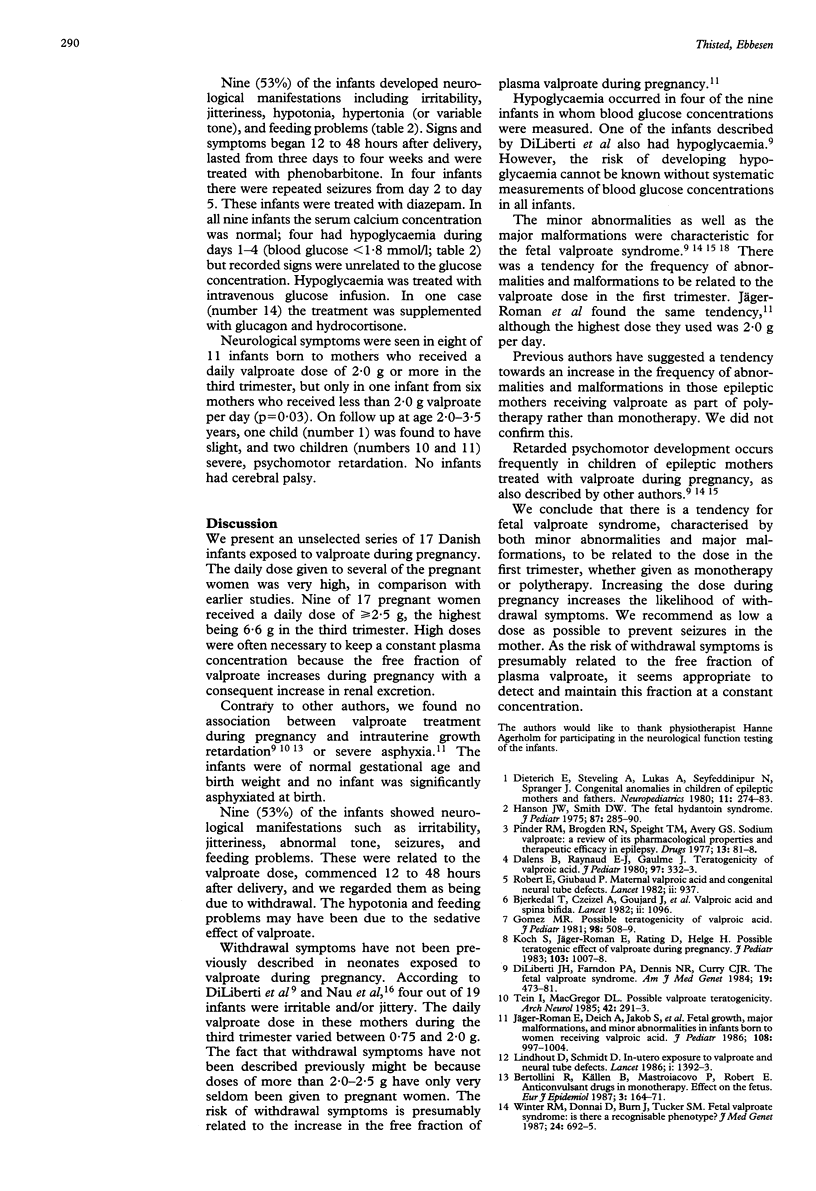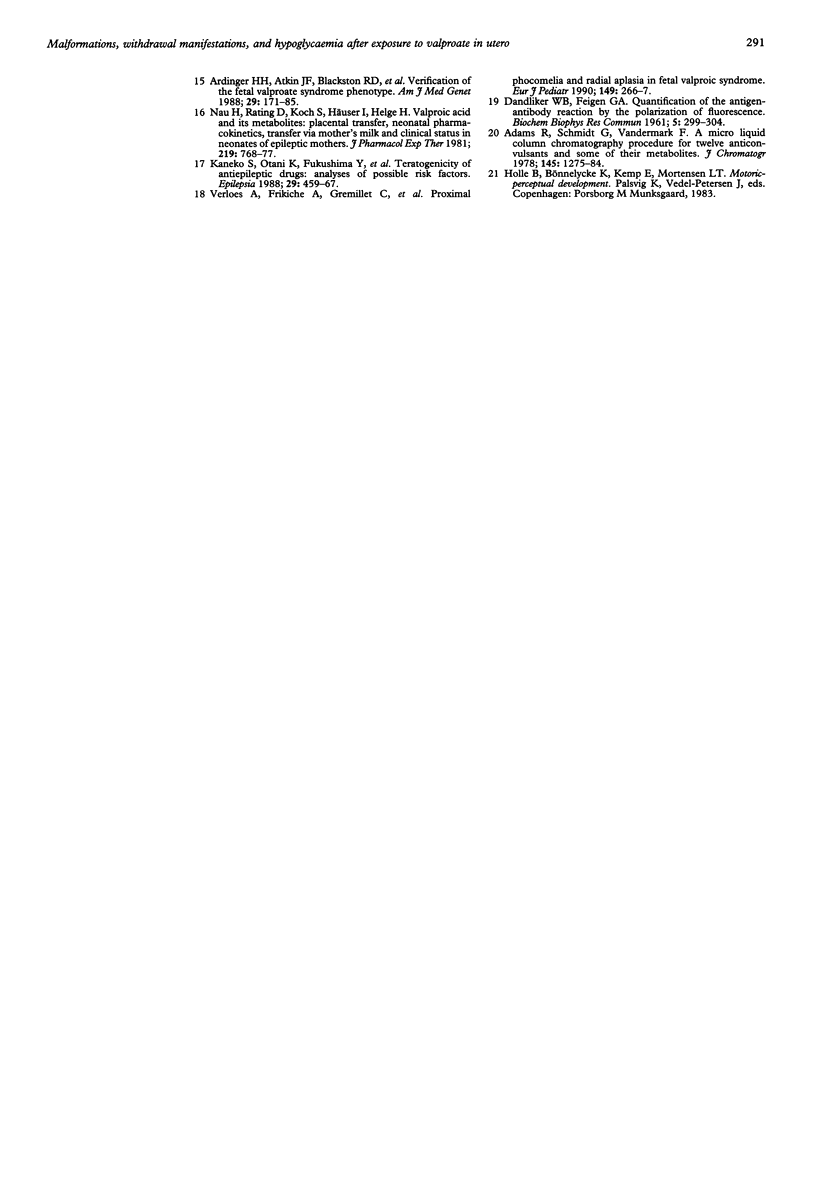Abstract
An unselected series is presented of 17 infants born to epileptic mothers and exposed to sodium valproate during pregnancy. Nine infants had minor abnormalities and of these infants five also had major malformations, described as the 'fetal valproate syndrome'. The most frequent malformation was congenital heart disease. Nine of the infants had manifestations of withdrawal, such as irritability, jitteriness, abnormalities of tone, seizures, and feeding problems. Four of these infants had an unrelated hypoglycaemia. The frequency of withdrawal symptoms was significantly related to the dose of valproate given to the mothers in the third trimester, and there was a tendency for both the frequency of the minor abnormalities and the major malformations to be related to the valproate dosage in the first trimester.
Full text
PDF



Selected References
These references are in PubMed. This may not be the complete list of references from this article.
- Ardinger H. H., Atkin J. F., Blackston R. D., Elsas L. J., Clarren S. K., Livingstone S., Flannery D. B., Pellock J. M., Harrod M. J., Lammer E. J. Verification of the fetal valproate syndrome phenotype. Am J Med Genet. 1988 Jan;29(1):171–185. doi: 10.1002/ajmg.1320290123. [DOI] [PubMed] [Google Scholar]
- Bertollini R., Källen B., Mastroiacovo P., Robert E. Anticonvulsant drugs in monotherapy. Effect on the fetus. Eur J Epidemiol. 1987 Jun;3(2):164–171. doi: 10.1007/BF00239754. [DOI] [PubMed] [Google Scholar]
- Bjerkedal T., Czeizel A., Goujard J., Kallen B., Mastroiacova P., Nevin N., Oakley G., Jr, Robert E. Valproic acid and spina bifida. Lancet. 1982 Nov 13;2(8307):1096–1096. doi: 10.1016/s0140-6736(82)90018-6. [DOI] [PubMed] [Google Scholar]
- DANDLIKER W. B., FEIGEN G. A. Quantification of the antigen-antibody reaction by the polarization of fluorescence. Biochem Biophys Res Commun. 1961 Jul 26;5:299–304. doi: 10.1016/0006-291x(61)90167-x. [DOI] [PubMed] [Google Scholar]
- Dalens B., Raynaud E. J., Gaulme J. Teratogenicity of valproic acid. J Pediatr. 1980 Aug;97(2):332–333. doi: 10.1016/s0022-3476(80)80517-8. [DOI] [PubMed] [Google Scholar]
- DiLiberti J. H., Farndon P. A., Dennis N. R., Curry C. J. The fetal valproate syndrome. Am J Med Genet. 1984 Nov;19(3):473–481. doi: 10.1002/ajmg.1320190308. [DOI] [PubMed] [Google Scholar]
- Dieterich E., Steveling A., Lukas A., Seyfeddinipur N., Spranger J. Congenital anomalies in children of epileptic mothers and fathers. Neuropediatrics. 1980 Aug;11(3):274–283. doi: 10.1055/s-2008-1071396. [DOI] [PubMed] [Google Scholar]
- Gomez M. R. Possible teratogenicity of valproic acid. J Pediatr. 1981 Mar;98(3):508–509. doi: 10.1016/s0022-3476(81)80743-3. [DOI] [PubMed] [Google Scholar]
- Hanson J. W., Smith D. W. The fetal hydantoin syndrome. J Pediatr. 1975 Aug;87(2):285–290. doi: 10.1016/s0022-3476(75)80604-4. [DOI] [PubMed] [Google Scholar]
- Jäger-Roman E., Deichl A., Jakob S., Hartmann A. M., Koch S., Rating D., Steldinger R., Nau H., Helge H. Fetal growth, major malformations, and minor anomalies in infants born to women receiving valproic acid. J Pediatr. 1986 Jun;108(6):997–1004. doi: 10.1016/s0022-3476(86)80949-0. [DOI] [PubMed] [Google Scholar]
- Kaneko S., Otani K., Fukushima Y., Ogawa Y., Nomura Y., Ono T., Nakane Y., Teranishi T., Goto M. Teratogenicity of antiepileptic drugs: analysis of possible risk factors. Epilepsia. 1988 Jul-Aug;29(4):459–467. doi: 10.1111/j.1528-1157.1988.tb03746.x. [DOI] [PubMed] [Google Scholar]
- Koch S., Jäger-Roman E., Rating D., Helge H. Possible teratogenic effect of valproate during pregnancy. J Pediatr. 1983 Dec;103(6):1007–1008. doi: 10.1016/s0022-3476(83)80750-1. [DOI] [PubMed] [Google Scholar]
- Lindhout D., Schmidt D. In-utero exposure to valproate and neural tube defects. Lancet. 1986 Jun 14;1(8494):1392–1393. doi: 10.1016/s0140-6736(86)91711-3. [DOI] [PubMed] [Google Scholar]
- Nau H., Rating D., Koch S., Häuser I., Helge H. Valproic acid and its metabolites: placental transfer, neonatal pharmacokinetics, transfer via mother's milk and clinical status in neonates of epileptic mothers. J Pharmacol Exp Ther. 1981 Dec;219(3):768–777. [PubMed] [Google Scholar]
- Pinder R. M., Brogden R. N., Speight T. M., Avery G. S. Sodium valproate: a review of its pharmacological properties and therapeutic efficacy in epilepsy. Drugs. 1977 Feb;13(2):81–123. doi: 10.2165/00003495-197713020-00001. [DOI] [PubMed] [Google Scholar]
- Robert E., Guibaud P. Maternal valproic acid and congenital neural tube defects. Lancet. 1982 Oct 23;2(8304):937–937. doi: 10.1016/s0140-6736(82)90908-4. [DOI] [PubMed] [Google Scholar]
- Tein I., MacGregor D. L. Possible valproate teratogenicity. Arch Neurol. 1985 Mar;42(3):291–293. doi: 10.1001/archneur.1985.04060030113019. [DOI] [PubMed] [Google Scholar]
- Verloes A., Frikiche A., Gremillet C., Paquay T., Decortis T., Rigo J., Senterre J. Proximal phocomelia and radial ray aplasia in fetal valproic syndrome. Eur J Pediatr. 1990 Jan;149(4):266–267. doi: 10.1007/BF02106290. [DOI] [PubMed] [Google Scholar]
- Winter R. M., Donnai D., Burn J., Tucker S. M. Fetal valproate syndrome: is there a recognisable phenotype? J Med Genet. 1987 Nov;24(11):692–695. doi: 10.1136/jmg.24.11.692. [DOI] [PMC free article] [PubMed] [Google Scholar]


